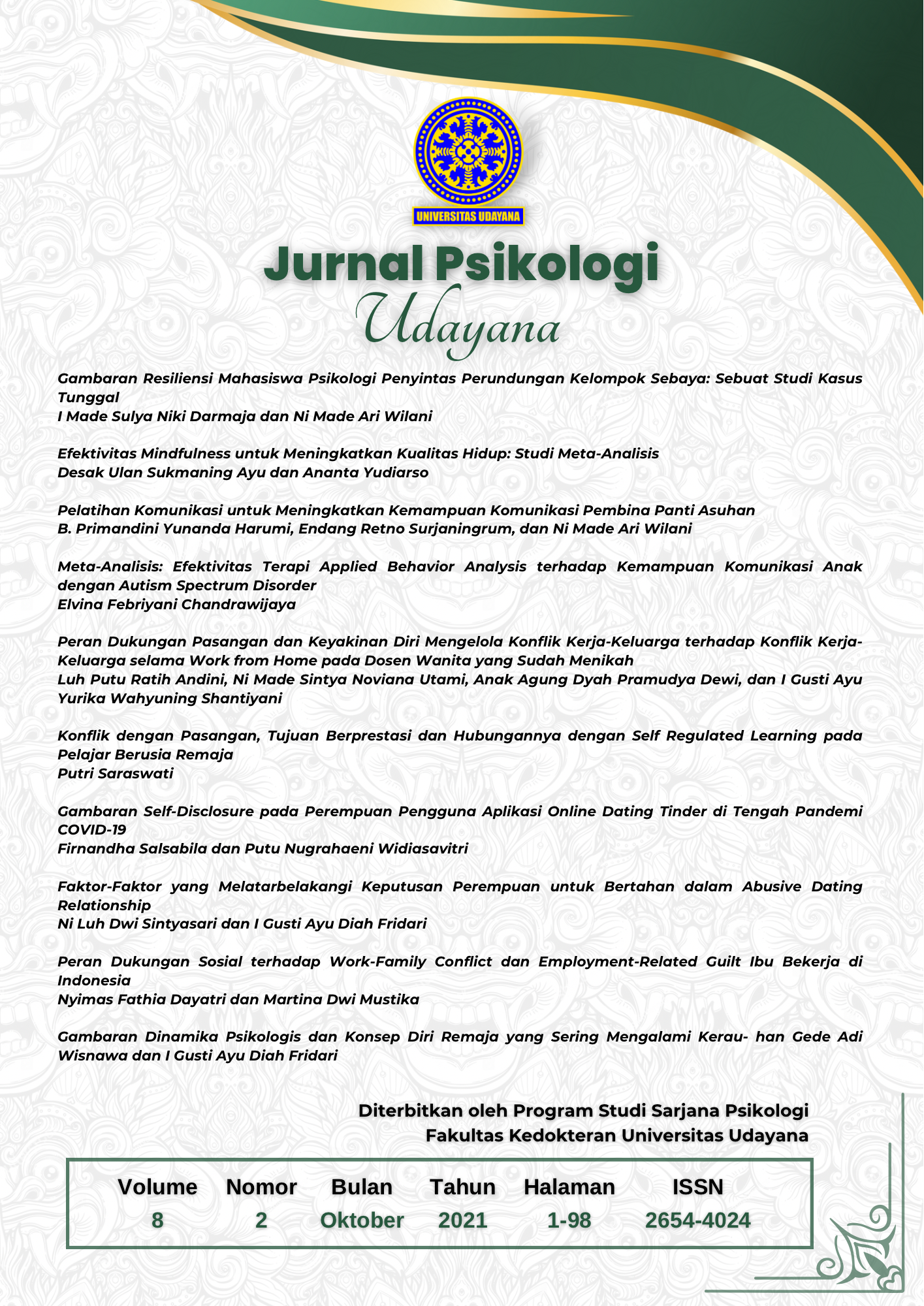Faktor-faktor yang melatarbelakangi keputusan perempuan untuk bertahan dalam abusive dating relationship
Abstract
Dating is a process of exploration and investigation of individuals in an intimate relationship. Having a relationship has a positive impact, but also has negative effects, one of which is abusive dating relationship. In an abusive dating relationship, women can choose to leave or stay in the relationship. A women’s decision to stay on the relationship caused by various factors. This research aimed to discover factors behind women’s decision to stay in abusive dating, utilizing a qualitative approach with a case study method. The sampling method used in this research is purposive sampling method. The respondents on this research were three women aged 21-23 years old who have been dating for more than one year and are staying in the abusive dating relationship. The results showed that commitment, cognitive bias, social support, relationship satisfaction, and positive reinforcement were factors behind women’s decision to stay on abusive dating relationship.
Downloads
References
Bell, K. M., & Naugle, A. E. (2005). Understanding Stay/Leave Decisions in Violent Relationships: A Behavior Analytic Approach. Behavior and Social Issues, 14(1), 21–46. https://doi.org/10.5210/bsi.v14i1.119
Brown, B. B., Feiring, C., & Furman, W. (1999). Missing the Love Boat: Why Researcher Have Shied Away From Adolescent Romance. In W. Furman, B. B. Brown, & C. Feiring (Eds.), The Development of Romantic Relationships in Adolescence (pp. 1–16). Cambridge University Press. https://doi.org/10.1017/CBO9781316182185.002
Callahan, M. R., Tolman, R. M., & Saunders, D. G. (2003). Adolescent Dating Violence Victimization and Psychological Well-Being. Journal of Adolescent Research, 18(6), 664–681. https://doi.org/10.1177/0743558403254784
Cohen, S., & Wills, T. A. (1985). Stress, Social Support, and the Buffering Hypothesis. Psychological Bulletin, 98(2), 310–357. https://doi.org/https://doi.org/10.1037/0033-2909.98.2.310
Dietrich, C. (2010). Decision Making: Factors that Influence Decision Making, Heuristics Used, and Decision Outcomes. Inquiries, 2(2), 1–3. http://www.inquiriesjournal.com/a?id=180
Dodge, K. A., Pettit, G. S., & Bates, J. E. (1994). Effects of physical maltreatment on the development of peer relations. Development and Psychopathology, 6(1), 43–55. https://doi.org/10.1017/S0954579400005873
Doyle-portillo, S., & Pastorino, E. (2010). What is Psychology ? Essentials. Wadsworth.
Edwards, K. M., Gidycz, C. A., & Murphy, M. J. (2014). Leaving an Abusive Dating Relationship: A Prospective Analysis of the Investment Model and Theory of Planned Behavior. Journal of Interpersonal Violence, 30(16), 2908–2927. https://doi.org/10.1177/0886260514554285
Edwards, K. M., Murphy, M. J., Tansill, E. C., Myrick, C., Probst, D. R., Corsa, R., & Gidycz, C. A. (2012). A qualitative analysis of college women’s leaving processes in abusive relationships. Journal of American College Health, 60(3), 204–210. https://doi.org/10.1080/07448481.2011.586387
Efendi, R. (2018). Akhir Tragis Gadis Medan Korban Pacar yang Terbakar Cemburu. Liputan6.Com. https://www.liputan6.com/regional/read/3534910/akhir-tragis-gadis-medan-korban-pacar-yang-terbakar-cemburu
Feist, J., Feist, G. J., & Roberts, T.-A. (2017). Teori Kepribadian (8th ed.). Salemba Humanika.
Furman, W., & Collibee, C. (2014). A matter of timing: Developmental theories of romantic involvement and psychosocial adjustment. Development and Psychopathology, 26(4), 1149–1160. https://doi.org/10.1017/S0954579414000182
Gómez-López, M., Viejo, C., & Ortega-Ruiz, R. (2019). Psychological well-being during adolescence: Stability and association with romantic relationships. Frontiers in Psychology, 10(JULY). https://doi.org/10.3389/fpsyg.2019.01772
Gressard, L. A., Swahn, M. H., & Tharp, A. T. (2015). A First Look at Gender Inequality as a Societal Risk Factor for Dating Violence. American Journal of Preventive Medicine, 49(3), 448–457. https://doi.org/10.1016/j.amepre.2015.05.017
Kementerian Pemberdayaan Perempuan dan Perlindungan Anak Republik Indonesia. (2018). Waspada Bahaya Kekerasan dalam Pacaran. https://www.kemenpppa.go.id/index.php/page/read/31/1669/waspada-bahaya-kekerasan-dalam-pacaran
King, L. A. (2014). Psikologi Umum Sebuah Pandangan Apresiatif (2nd ed.). Salemba Humanika.
La Bella, L. (2015). Dating Violence (1st ed.). Rosen Publisher.
Lakey, B., & Cohen, S. (2000). Social Support Theory and Measurement. In S. Cohen, L. G. Underwood, & B. H. Gottlieb (Eds.), Social Support Measurement and Interventions: A Guide For Health and Social Scientists (pp. 29–52). Oxford University Press. https://doi.org/10.1093/med:psych/9780195126709.003.0010
Lily, H. M. (2012). Dating Violence (1st ed.). Rosen Publisher.
Machisa, M. T., Christofides, N., & Jewkes, R. (2018). Social support factors associated with psychological resilience among women survivors of intimate partner violence in Gauteng, South Africa. Global Health Action, 11(3), 1–9. https://doi.org/https://doi.org/10.1080/16549716.2018.1491114
Mattson, R. E., Rogge, R. D., Johnson, M. D., Davidson, E. K. B., & Fincham, F. D. (2012). The positive and negative semantic dimensions of relationship satisfaction. Journal of the International Association for Relationship Research, 20(2), 328–355. https://doi.org/10.1111/j.1475-6811.2012.01412.x
Miller, K. B., Lund, E., & Weatherly, J. (2012). Applying Operant Learning to the Stay-Leave Decision in Domestic Violence. Behavior and Social Issues, 21(1), 135–151. https://doi.org/10.5210/bsi.v21i0.4015
Munandar, A. S. (2014). Psikologi Industri dan Organisasi. Universitas Indonesia.
Ogolsky, B. G., & Surra, C. A. (2014). A comparison of concurrent and retrospective trajectories of commitment to wed. Journal of the International Association for Relationship Research, 21(4), 620–639. https://doi.org/10.1111/pere.12054
Park, Y., Mulford, C., & Blachman-Demner, D. (2018). The acute and chronic impact of adolescent dating violence: A public health perspective. In D. A. Wolfe & J. R. Temple (Eds.), Adolescent Dating Violence: Theory, Research, and Prevention (pp. 53–83). Elsevier Inc. https://doi.org/10.1016/B978-0-12-811797-2.00003-7
Perempuan, K. (2020). Catatan Tahunan Komnas Perempuan. https://www.komnasperempuan.go.id/file/pdf_file/2020/Catatan Tahunan Kekerasan Terhadap Perempuan 2020.pdf
Rakovec-Felser, Z. (2014). Domestic violence and abuse in intimate relationship from public health perspective. Health Psychology Research, 2(3), 62–67. https://doi.org/10.4081/hpr.2014.1821
Rauer, A. J., Pettit, G. S., Lansford, J. E., Bates, J. E., & Dodge, K. A. (2013). Romantic relationship patterns in young adulthood and their developmental antecedents. Developmental Psychology, 49(11), 2159–2171. https://doi.org/10.1037/a0031845
Rhoades, G. K., Stanley, S. M., & Markman, H. J. (2010). Should I Stay or should I go? Predicting dating relationship stability from four aspects of commitment. Journal of Family Psychology, 24(5), 543–550. https://doi.org/10.1037/a0021008
Rismelina, D. (2020). Pengaruh strategi koping dan dukungan sosial terhadap resiliensi pada mahasisiwi korban kekerasan dalam rumah tangga. Psikoborneo, 8(2), 195–201.
Rodriguez, L. M., Hadden, B. W., & Knee, C. R. (2015). Not all ideals are equal: Intrinsic and extrinsic ideals in relationships. Journal of the International Association for Relationship Research, 22(1), 138–152. https://doi.org/10.1111/pere.12068
Rohmah, S., & Legowo, M. (2014). Motif Kekerasan Dalam Relasi Pacaran di kalangan Remaja Muslim. Paradigma, 2(1), 1–9.
Rowan, J., & Hallen, P. (2010). Dating - Philosophy for Everyone. In F. Allhoff, K. Miller, & M. Clark (Eds.), Dating - Philosophy for Everyone (Issue 2006, pp. 49–64). Blackwell Publishing. https://doi.org/10.1002/9781444324549
Rusbult, C. E., & Buunk, B. P. (1993). Commitment processes in close relationships: An interdependence analysis. Journal of Social and Personal Relationships, 10(2), 175–204. https://doi.org/10.1177/026540759301000202
Safitri, W. A., & Sama’I, D. (2013). Dampak Kekerasan Dalam Berpacaran (The Impact Of Violence In Dating). Artikel Ilmiah Hasil Penelitian Mahasiswa UNEJ, 1(1), 1–6. http://repository.unej.ac.id/handle/123456789/57669
Santrock, J. W. (2010). Life-Span Development (13th ed., Vol. 4, Issue 1). McGraw-Hill.
Sari, I. P. (2018). dalam relasi pacaran. Perempuan korban cenderung menjadi makhluk irasional dengan mempertahankan relasi pacarannya dengan pertimbangan keuntungan berupa terhindar dari. Jurnal Dimensia, 7(1), 64–85. https://doi.org/https://doi.org/10.21831/dimensia.v7i1.21055
Sari, R. P. (2019). Kesha Ratuliu Pernah Alami Kekerasan Fisik dan Verbal dari Mantan Kekasih. Kompas.Com. https://www.kompas.com/hype/read/2020/01/09/151500066/kesha-ratuliu-pernah-alami-kekerasan-fisik-dan-verbal-dari-mantan-kekasih?page=all#page2
Sekarlina, I., & Margaretha. (2013). Stockholm Syndrome pada Wanita Dewasa Awal yang Bertahan dalam Hubungan yang Penuh Kekerasan. Jurnal Psikologi Klinis Dan Kesehatan Mental, 02(03), 1–6.
Shefrin, H. (2007). Behavioral corporate finance: decisions that create values. McGraw-Hill.
Sholikhah, R., & Masykur, A. M. (2020). “ATAS NAMA CINTA, KU RELA TERLUKA” (Studi Fenomenologi pada Perempuan Korban Kekerasan Dalam Pacaran). Empati, 8(4), 52–62.
Statistics Indonesia. (2017). SPHPN 2016: Prevalensi Kekerasan Terhadap Perempuan di Indonesia. In Badan Pusat Statistik (BPS) (Issue 29/03). https://www.bps.go.id/pressrelease/2017/03/30/1375/satu-dari-tiga-perempuan-usia-15---64-tahun-pernah-mengalami-kekerasan-fisik-dan-atau-seksual-selama-hidupnya.html
Strauss, A., & Corbin, J. (2003). Dasar-Dasar Penelitian Kualitatif. Pustaka Belajar.
Sudarmiati, S., & Irawadhi, D. A. L. (2016). Pengalaman Dating Violence pada Remaja Putri. MUSWIL IPEMI Jateng, September 2016, 219–232. https://ppnijateng.org
Sullivan, T. P., Schroeder, J. A., Dudley, D. N., & Dixon, J. M. (2010). Do differing types of victimization and coping strategies influence the type of social reactions experienced by current victims of intimate partner violence? Violence Against Women, 16(6), 638–657. https://doi.org/10.1177/1077801210370027
Sylaska, K. M., & Edwards, K. M. (2014). Disclosure of Intimate Partner Violence to Informal Social Support Network Members: A Review of the Literature. Trauma, Violence, and Abuse, 15(1), 3–21. https://doi.org/10.1177/1524838013496335
Taylor, S. E., Peplau, L. A., & Sears, D. O. (2009). Psikologi Sosial (12th ed.). Kencana.
Theran, S. A., Sullivan, C. M., Bogat, G. A., & Stewart, C. S. (2006). Women ’ s Well-Being. Violence Against Women, 12(10), 950–969. https://doi.org/10.1177/1077801206292871
Tversky, A., & Kahneman, D. (1983). Extensional Versus Intuitive Reasoning: The Conjunction Fallacy in Probability Judgment. American Psychological Association, 90(4), 293–315. https://doi.org/10.1007/BF00712851
Untari, P. (2014). Hubungan Antara Empati dengan Sikap Pemaaf pada Remaja Putri yang Menagalami Kekerasan dalam Berpacaran. EJournal Psikologi, 2(2), 279–289.
Viejo, C. (2014). Physical Dating Violence: towards a comprehensible view of the phenomenon. Journal for the Study of Education and Development, 37(4), 785–815. https://doi.org/10.1080/02103702.2014.977110
Walker, L. E. A. (2009). The battered woman. In American Journal of Obstetrics and Gynecology (3rd ed.). Springer Publishing Company. https://doi.org/10.1016/0002-9378(95)90322-4
Walker, S. (1975). Essential Psychology Learning and Reinforcement (P. Herriot (ed.)). Metheun & Co Ltd.
West, R. F., Toplak, M. E., & Stanovich, K. E. (2008). Heuristics and Biases as Measures of Critical Thinking: Associations with Cognitive Ability and Thinking Dispositions. Journal of Educational Psychology, 100(4), 930–941. https://doi.org/10.1037/a0012842
Wishesa, A. I., & Suprapti, V. (2014). Dinamika emosi remaja perempuan yang sedang mengalami kekerasan dalam pacaran. Jurnal Psikologi Pendidikan Dan Perkembangan, 3(3), 159–163.

This work is licensed under a Creative Commons Attribution-ShareAlike 4.0 International License.
Authors who publish with this journal agree to the following terms:
- Authors retain copyright and grant the journal right of first publication with the work simultaneously licensed under a Creative Commons Attribution-ShareAlike 4.0 International License that allows others to share the work with an acknowledgement of the works authorship and initial publication in this journal.
- Authors are able to enter into separate, additional contractual arrangements for the non-exclusive distribution of the journals published version of the work (e.g., post it to an institutional repository or publish it in a book), with an acknowledgement of its initial publication in this journal.
- Authors are permitted and encouraged to post their work online (e.g., in institutional repositories or on their website) prior to and during the submission process, as it can lead to productive exchanges, as well as earlier and greater citation of published work (See The Effect of Open Access).













